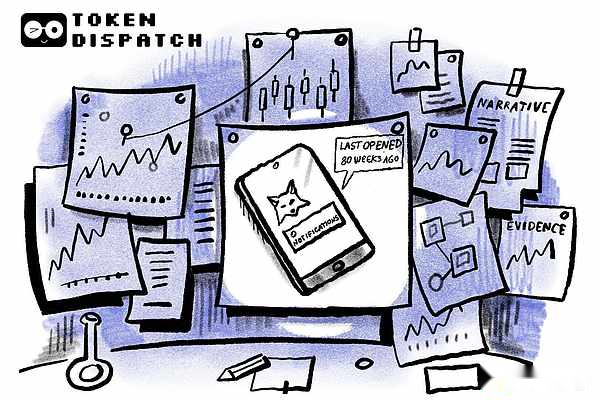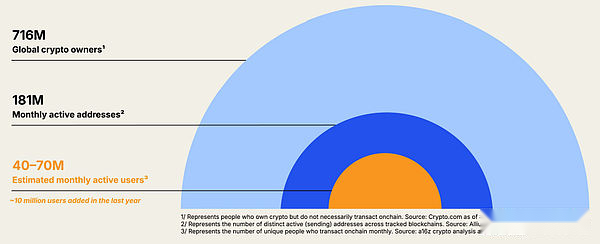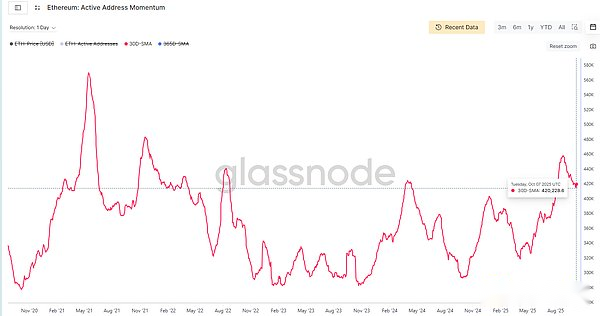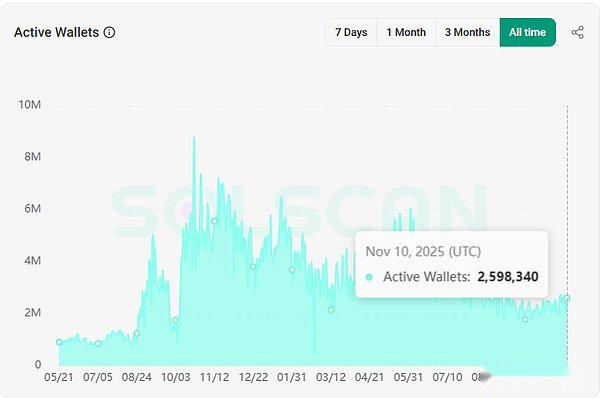
Author: Prathik Desai, Source: Token Dispatch, Compiler: Shaw Bitcoin Vision
On paper, the base user base of cryptocurrencies is huge.The number of people around the world who hold some form of digital asset is now at a record high, exceeding 700 million.If it were considered a country, it would be the third largest in the world, after China and India.
Cryptocurrency popularity has grown sevenfold in less than five years.At first glance, this progress seems rapid and huge, giving the impression that the popularity of cryptocurrency has expanded significantly.However, a closer look at other data reveals that the reality is far more complex than this.
In this week’s Quantitative Analysis, I’m bringing in more data and charts to add color to better understand the difference between cryptocurrency holdings and usage.

Perhaps cryptocurrencies are not really waiting for the next 100 million users to join, but rather for the hundreds of millions of existing users to become more active.
According to the “State of Cryptocurrency 2025” report released by a16z crypto, the number of cryptocurrency holders holding any digital asset was 716 million as of August 31, 2025.Compared with other reported data in the past, this number has increased sevenfold from 100 million in 2021.
This is indeed an excellent title.But when you look at the proportion of these digital asset holders who are actively using or trading their assets, something is questionable.

The chart shows that of the 716 million cryptocurrency holders, less than 10% trade cryptocurrencies as monthly active users (MAU).This number raises a number of possibilities.
Over the past 16 years, some holders may have purchased cryptocurrencies for trial purposes and then forgotten about them.Others may use off-chain centralized platforms for cryptocurrency trading.Still others may choose traditional routes, such as exchange-traded funds (ETFs) or buying shares of digital asset treasury (DAT) companies, to access cryptocurrency investment opportunities.
All of this and more can make interpreting these numbers difficult.
Nonetheless, an undoubted sign is that of the 40 million to 70 million monthly active on-chain users, at least 10 million were added in the last year.
It is evident from the on-chain data that there is a high dormancy rate among wallet holders.
Of the 350 million wallet addresses created since the birth of Ethereum, less than 1% are currently active.

While the 30-day moving average (SMA) of active addresses on Ethereum increased from 400,000 in April 2024 to 460,000 in August 2025, the SMA has since dropped below 420,000 active wallet addresses.
Solana’s situation is even worse.

As of November 10, the number of live active wallets (those with at least one signature in the past year) on Solana has dropped to 2.6 million, down from an average of more than 5 million between October and December 2024.
This decline in behavior is not only reflected on the chain, but also at the user level wallet layer, which is the application that most users actually use.
MetaMask is the most popular self-hosted wallet in the cryptocurrency space with over 143 million installations.But only about 30 million people open the app every month, and the activation rate is only 21%.
The situation of Trust Wallet is even worse: it has more than 200 million installations, but only 17 million monthly active users, accounting for only 8.5%.
Only the Phantom wallet based on Solana has relatively higher user activity and user stickiness.This wallet has more than 15 million monthly active users based on approximately 24 million downloads.
Even taking Phantom’s data into account, 85% of users across the three largest wallets are still inactive.
Comparing this data to mainstream fintech companies shows that most cryptocurrency applications and blockchain still have a long way to go.Payment app Venmo has a monthly active user ratio of 35% to 40%.PayPal’s user retention rate is also about the same, even taking into account 2024 demographics.
You can attribute this contrast to cryptocurrencies to “behavior in the early stages.”However, when the installed base reaches hundreds of millions but the number of active users is only tens of millions, this may indicate a problem with the product itself rather than a problem with growth.
So what causes this gap between ownership and usage?
The cryptocurrency space is rife with complexities, from cross-chain bridge protocols to mnemonic phrases to fees.These complexities make cryptocurrencies easy to buy, but hard to use, and harder to come back to once users give up due to inconvenience.
This may be the key to solving the problem of cryptocurrency popularity.Cryptocurrency doesn’t have to become Venmo overnight, but it can look to the future and seize opportunities.The next batch of 100 million users are actually already inside the system, not outside it.All they need is a reason to get active again.
Cryptocurrency developers need to give them a reason to come back.
The answer may not lie in dashboards or token trackers, but in building solutions that embed wallets as intangible components into products.There are many examples worth learning from in the cryptocurrency field.
On Farcaster, users can mint and vote NFTs in social feeds through Frames without the need for a separate wallet popup or decentralized application (dApp).Many Telegram bots allow users to exchange tokens, send tips and earn money directly in the chat.The on-chain summer event on Base brings millions of users a convenient registration experience without handling fees through a simple minting page.
OpenAI’s ChatGPT is another example.This artificial intelligence product currently has more than 800 million weekly active users, and its number of new users per week exceeds the number of new users per month for most crypto wallets or blockchains.And, it does this with fewer steps, lower friction, and zero speculative loops.
If cryptocurrency developers follow this lead, especially when it comes to solving mass adoption issues, the 716 million wallets number might be able to translate into something more meaningful.






